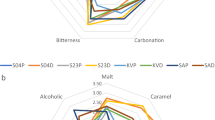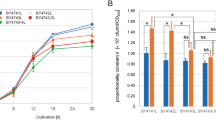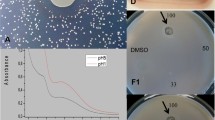Abstract
AFTER being dried at 90° C., bakers' yeast pre-treated with sodium fluoride assumes a more or less strong red colour, all according to the pH of the solution in which the yeast has been shaken. On the other hand, untreated yeast assumes a yellow colour after drying. With concentrated hydrochloric acid there is obtained from the red yeast a wine-red extract, which has a pronounced maximum at 4900 A. Fig. l shows the absorption spectrum of the extract in half concentrated hydrochloric acid.
This is a preview of subscription content, access via your institution
Access options
Subscribe to this journal
Receive 51 print issues and online access
$199.00 per year
only $3.90 per issue
Buy this article
- Purchase on Springer Link
- Instant access to full article PDF
Prices may be subject to local taxes which are calculated during checkout
Similar content being viewed by others
References
Bardachzi, F., Hoppe-Seylers Z., 48, 145 (1906).
Jordan, C, and Pryde, J., Biochem. J., 32, 279 (1938).
Ohyama, Y., J. Biochem., 27, 351 (1938).
Karaoglanov, Z., Z. analyt. Chem., 121, 92 (1941).
Nilsson, R., Sv. Vet. Ak. ArK. Kemi, Mineral, och GeoL., A, 10, No. 7 (1930).
Neuberg, C, and Kobel, M., Biochem. Z., 263, 221; 264, 456 (1933).
Meyerhof, O., and Kiessling, W., Biochem. Z., 267, 331 (1933).
Myrbäck, K., and Ortenblad, B., Biochem. Z., 292, 230 (1937).
Author information
Authors and Affiliations
Rights and permissions
About this article
Cite this article
MALM, M. A Colour Reaction in Yeast. Nature 156, 52–53 (1945). https://doi.org/10.1038/156052a0
Issue Date:
DOI: https://doi.org/10.1038/156052a0
Comments
By submitting a comment you agree to abide by our Terms and Community Guidelines. If you find something abusive or that does not comply with our terms or guidelines please flag it as inappropriate.



